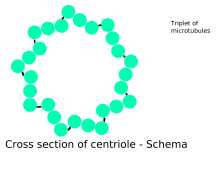Centriole


A centriole is a barrel shaped organelle[1] found in most eukaryotic cells, though absent in higher plants and fungi.[2] The walls of each centriole are usually composed of nine triplets of microtubules. Deviations from this include Drosophila melanogaster embryos, with nine doublets and Caenorhabditis elegans sperm cells and early embryos, with nine singlets.[3] [4] An associated pair of centrioles, arranged perpendicularly, constitutes the compound structure known as the centrosome.[1]
Function
Cells usually contain two complete centrioles. During cell replication, a new centriole will grow from the side of each of the preexisting centrioles. Each daughter cell formed after cell division will inherit one of these pairs (one older and one newer centriole). If the centrioles are used in forming flagella or cilia, the older of the two centrioles, the mother centriole, becomes the basal body which organizes the structure of the organelle.[5]
References
- ^ a b B. Edde, J. Rossier, J.P. Le Caer, E. Desbruyeres, F. Gros & P. Denoulet (1990). "Posttranslational glutamylation of alpha-tubulin". Science. 247: 83–85.
{{cite journal}}: CS1 maint: multiple names: authors list (link) - ^ L.M. Quarmby & J.D.K. Parker (2005). "Cilia and the cell cycle?". J. Cell Biol. 169 (5): 707–710. doi:10.1083/jcb.200503053.
{{cite journal}}: Unknown parameter|month=ignored (help) - ^ Marie Delattre and Pierre Gönczy, The arithmetic of centrosome biogenesis, Journal of Cell Science 117, 1619-1630 (2004)
- ^ SAS-6 defines a protein family required for centrosome duplication in C. elegans and in human cells, Nature Cell Biology 7, 115 - 125 (2005)
- ^ Beisson, J. and Wright M. (2003). Basal body/centriole assembly and continuity. Current Opinion in Cell Biology 15, 96-104.
